Get Free NCERT Solutions for Class 11 Maths Chapter 9 Sequences and Series Ex 9.2 PDF in Hindi and English Medium. Sequences and Series Class 11 Maths NCERT Solutions are extremely helpful while doing your homework. Sequences and Series Ex 9.2 Class 11 Maths NCERT Solutions were prepared by Experienced LearnCBSE.in Teachers. Detailed answers of all the questions in Chapter 9 Class 11 Sequences and Series Ex 9.2 provided in NCERT Textbook.
- Sequences and Series Class 11 Ex 9.1
- Sequences and Series Class 11 Ex 9.2
- Sequences and Series Class 11 Ex 9.3
- Sequences and Series Class 11 Ex 9.4
- Sequences and Series Class 11 Miscellaneous Exercise
- अनुक्रम तथा श्रेणी प्रश्नावली 9.1 का हल हिंदी में
- अनुक्रम तथा श्रेणी प्रश्नावली 9.2 का हल हिंदी में
- अनुक्रम तथा श्रेणी प्रश्नावली 9.3 का हल हिंदी में
- अनुक्रम तथा श्रेणी प्रश्नावली 9.4 का हल हिंदी में
- अनुक्रम तथा श्रेणी विविध प्रश्नावली का हल हिंदी में
- Sequences and Series Class 11 Notes
- NCERT Exemplar Class 11 Maths Sequences and Series
- JEE Main Mathematics Sequences and Series Previous Year Questions
Free download NCERT Solutions for Class 11 Maths Chapter 9 Sequences and Series Ex 9.2 PDF in Hindi Medium as well as in English Medium for CBSE, Uttarakhand, Bihar, MP Board, Gujarat Board, BIE, Intermediate and UP Board students, who are using NCERT Books based on updated CBSE Syllabus for the session 2019-20.
NCERT Solutions for Class 11 Maths Chapter 9 Ex 9.2

Question 1:
Find the sum of odd integers from 1 to 2001.
Ans:
The odd integers from 1 to 2001 are 1, 3, 5, … 1999, 2001.
This sequence forms an A.P.
Here, first term, a = 1
Common difference, d = 2
Here, a + (n – 1) d = 2001
⇒ 1 + (n -1) (2) = 2001
⇒ 2n – 2 = 2000
⇒ n = 1001
Sn = \(\frac{n}{2}\) [2a + (n – 1)d]
= \(\frac{1001}{2}\) [2 × 1 + (1001 – 1) × 2]
= \(\frac{1001}{2}\) [2 + 1000 x 2]
= \(\frac{1001}{2}\) × 2002
= 1001 × 1001
= 1002001
Thus, the sum of odd numbers from 1 to 2001 is 1002001.
Question 2:
![]()
Ans:
The natural numbers lying between 100 and 1000, which are multiples of 5 are 105, 110, …, 995.
Here, a = 105 and d = 5
a + (n – 1) d = 995
⇒ 105 + (n -1)5 = 995
⇒ (n – 1)5 = 995 – 105 = 890
⇒ n – 1 = 178
⇒ n = 179
Sn = \(\frac{179}{2}\) [2 (105) + (179 – 1) (5)]
= \(\frac{179}{2}\) [2 (105) + (178) (5)]
= 179 [105 + (89)5]
= (179) (105 + 445)
= (179) (550) = 98450
Thus, the sum of all natural numbers lying between 100 and 1000, which are multiples of 5 is 98450.
Question 3:
In an A.P. the first term is 2 and the sum of the first five terms is one-fourth of the next five terms. Show that 20th term is – 112.
Ans:
Let the first term of given AP be a and common difference be d.
We have, T1 = a = 2
T1 + T2 + T3 + T4 + T5 = [T6 + T7 + T8 + T9 + T10]
Sum of 5 terms, where first term is a = \(\frac{1}{4}\) × sum of 5 terms, where first term is (a + 5d)
⇒ \(\frac{5}{2}\) [2a + (5 – 1) d] = \(\frac{1}{4}\) × \(\frac{5}{2}\) [2(a + 5d) + (5 – 1)d]
[∵ Sn = \(\frac{n}{2}\) [2a + (n – 1)d]]
\(\frac{5}{2}\) [2a + 4d] = \(\frac{1}{4}\) × \(\frac{5}{2}\) [2a + 10d + 4d]
\(\frac{5}{2}\) [2a + 4d] = \(\frac{1}{4}\) × \(\frac{5}{2}\) [2a + 14d]
⇒ 2a + 4d = \(\frac{1}{4}\) [2a + 14d]
2(2) + 4d = \(\frac{1}{4}\) [2 . (2) + 14d] [put a = 2]
4 + 4d = \(\frac{1}{4}\) [4 + 14d]
16 + 16d = 4 + 14d
16d – 14d = 4 – 16
2d = – 12
d = – 6
T20 = a + (20 – 1) d
= 2 + 19 × (- 6)
= 2 – 114 = – 112
Hence proved.
Question 4:
How many terms of the A.P. – 6, – \(\frac{11}{2}\), – 5, … are needed to give the sum – 25?
Ans:
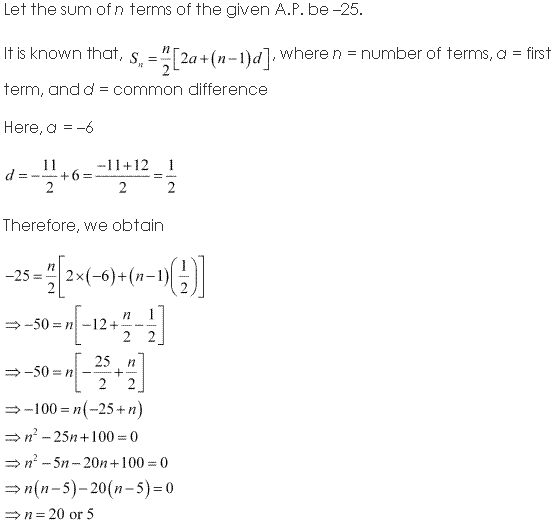
Question 5:
In an A.P., if pth term is \(\frac{1}{q}\) and qth term is \(\frac{1}{p}\), prove that the sum of first pq terms is \(\frac{1}{2}\) (pq + 1), where pq ≠ q.
Ans:
It is known that the general term of an A.P. is
an = a + (n – 1) d
According to the given information,
pth term = ap
= a + (p – 1)d = \(\frac{1}{q}\) …………..(i)
qth term = aq
= a + (q – 1)d = \(\frac{1}{p}\) …………….(ii)
Subtracting eq. (ii) from eq. (i), we obtain
(p – 1) d – (q – 1) d = \(\frac{1}{q}-\frac{1}{p}\)
(p – 1 – q + 1) d = \(\frac{p-q}{p q}\)
⇒ (p – q) d = \(\frac{p-q}{p q}\)
d = \(\frac{1}{p q}\)
Putting the value of d in eq. (i), we obtain
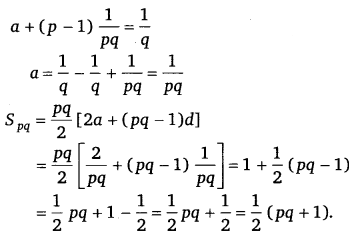
Question 6:
If the sum of a certain number, of terms of the A.P. 25, 22, 19, …is 116. Find the last term
Ans:
Let the sum of n terms of the given A.P. be 116.
Sn = \(\frac{n}{2}\) [2a + (n – 1)d]
Here, a = 25 and d = 22 – 25 = – 3
Sn = \(\frac{n}{2}\) [2 × 25 + (n – 1) (- 3)]
⇒ 116 = \(\frac{n}{2}\) [50 – 3n + 3]
⇒ 232 = n(53 – 3n) = 53n – 3n2
3n2 – 24n – 29n + 232 = 0
3n (n – 8) – 29 (n – 8) = 0
(n – 8) (3n – 29) = 0
n = 8 or n = \(\frac{29}{3}\)
However, n cannot be equal to \(\frac{29}{3}\).
Therefore, n = 8
∴ a8 = Last term = a + (n -1) d = 25 + (8 – 1) (- 3)
= 25 + (7) (- 3) = 25 – 21 = 4
Thus, the last term of the A.P. is 4.
Question 7:
![]()
Ans:
It is given that the kth term of the A.P. is 5k + 1
kth term = ak = a + (k – 1) d
a + (k – 1) d = 5k +1
a + kd – d = 5k + 1
Comparing the coefficient of k, we obtain d = 5
a – d = 1
⇒ a – 5 = 1
⇒ a = 6
Sn = \(\frac{n}{2}\) [2a + (n – 1) d]
= \(\frac{n}{2}\) [2 (6) + (n – 1) (5)]
= \(\frac{n}{2}\) [12n + 5n – 5]
= \(\frac{n}{2}\) (5n + 7).
Question 8:
![]()
Ans:
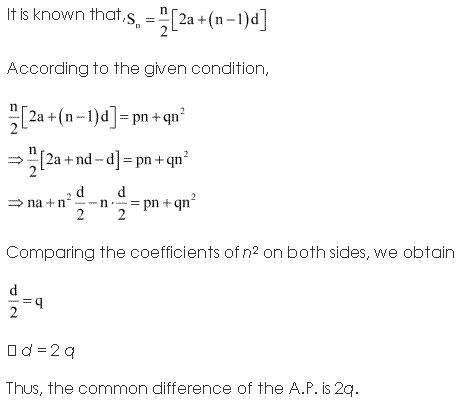
Question 9:
The sums of n terms of two arithmetic progressions are in the ratio 5n + 4 : 9n + 6. Find the ratio of their 18th terms.
Ans:
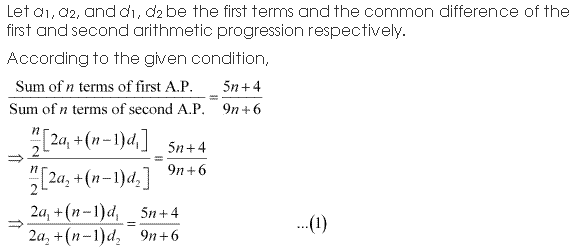
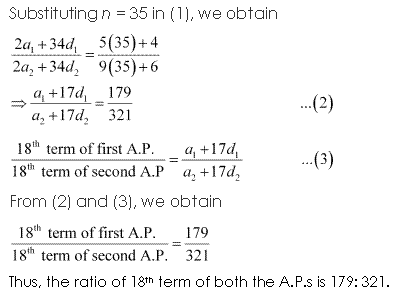
Question 10:
If the sum of first p terms of an A.P. is equal to the sum of the first q terms, then find sum of the first (p + q) terms.
Ans:
Let a and b be the first term and the common difference of the A.P. respectively.
Here, Sp = \(\frac{p}{2}\) [2a + (p – 1)d]
Sq = \(\frac{q}{2}\) [2a + (q – 1 )d]
According to the given condition,
\(\frac{p}{2}\) [2a + (p – 1) d] = \(\frac{q}{2}\) [2a + (q – 1) d]
p [2a + (p – 1) d] = q [2a + (n – 1) d]
2ap + pd (p – 1) d = 2aq + qd (q – 1) d
2a (p – q) + d[p(p – 1) – q (q – 1)] = 0
2a (p – q) + d[p2 – p – q2 + q] = 0
2a (p – q) + d [(p – q) (p + q) – (p – q)] = 0
2a (p – q) + d [(p – q) (p + q – 1)] = 0
2a + d (p + q – 1) = 0
d = \(\frac{-2 a}{p+q-1}\) ……………..(i)
∴ Sp + q = \(\frac{p+q}{2}\) [2a + (p + q – 1) d]
Sp + q = \(\frac{p+q}{2}\left[2 a+(p+q-1)\left(\frac{-2 a}{p+q-1}\right)\right]\) [from eq. (i)]
= \(\frac{p+q}{2}\) [2a – 2a] = 0
Thus, the sum of the first (p + q) terms of the A.P. is 0.
Question 11:

Ans:
Given that, Sp = a, Sq = b, Sc = r
Let A be the first term and d be the common difference. Then,
Sp = \(\frac{p}{2}\) [2A + (p – 1) d] = a
2A + (p – 1) d = \(\frac{2 a}{p}\) ……………(i)
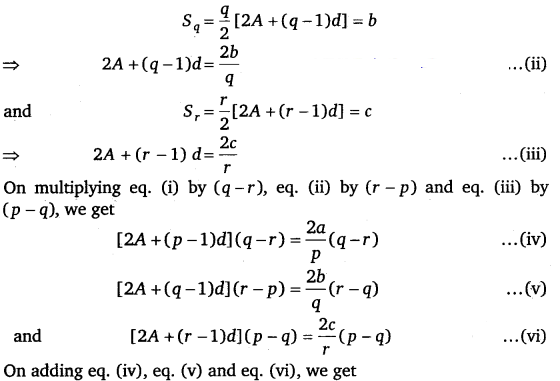
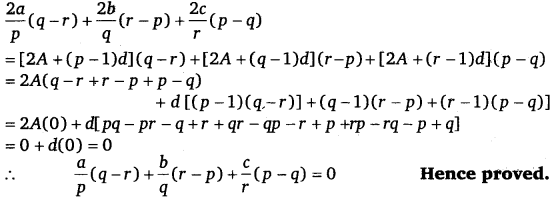
Question 12:
![]()
Ans:
Let the first term “be a and common difference be d.
Thus, Sm = \(\frac{m}{2}\) [2a + (m – 1)d] and Sn = \(\frac{n}{2}\) [2a + (n – 1)d]
According to the given condition.
\(\frac{S_{m}}{S_{n}}=\frac{m^{2}}{n^{2}}\)
\(\frac{\frac{m}{2}[2 a+(m-1) d]}{\frac{n}{2}[2 a+(n-1) d]}=\frac{m^{2}}{n^{2}} \Rightarrow \frac{2 a+(m-1) d}{2 a+(n-1) d}=\frac{m}{n}\)
2an + (mn – n) d = 2am + (mn – m)d
2an – 2am = (mn – m – mn + n)d
2a (n – m) = d (n – m)
⇒ d = 2a .
Tm = a + (m – 1) d = a + (m – 1) 2a
Tm = a + 2am – 2a
Tm = 2am – a
⇒ Tm = a (2m – 1) ……………..(i)
Also, Tn = a (2n – 1) ………………(ii)
On dividing eQuestion (i) by eQuestion (ii), we get
\(\frac{T_{m}}{T_{n}}=\frac{a(2 m-1)}{a(2 n-1)}=\frac{2 m-1}{2 n-1}\)
Hence proved.
Question 13:
![]()
Ans:
Let a and b be the first term and the common difference of the A.P., respectively
am = a + (m – 1) d = 164 ……………(i)
Sum of n terms
Here, \(\frac{n}{2}\) [2a + nd – d] = 3n2 + 5n
\(n a+\frac{n^{2} d}{2}-\frac{n d}{2}=3 n^{2}+5 n\)
\(\frac{n^{2} d}{2}+n\left(a-\frac{d}{2}\right)\) = 3n2 + 5n
Comparing the coefficient of n2 on both sides, we obtain
\(\frac{d}{2}\) = 3
⇒ d2 = 2 × 3 = 6
Comparing the coefficient of n on both sides, we obtain
a – \(\frac{d}{2}\) = 5
a – \(\frac{6}{2}\) = 5
a = 5 + 3 = 8
Therefore, from eq. (i), we obtain
8 + (m – 1) 6 = 164
⇒ (m – 1) 6 = 164 – 8 = 156
⇒ m – 1 = 26
⇒ m = 27
Thus the value of m is 27.
Question 14:
![]()
Ans:
Let A1, A2, A3, A4 and A5 be five numbers between 8 and 26 such that 8, A1, A2, A3, A4, A5, 26 is an A.P.
Here, a = 8, b = 26, n = 7
Therefore, 26 = 8 + (7 – 1)d
6d = 26 – 8 = 18
d = 3
A1 = a + d = 8 + 3 = 11
A2 = a + 2d = 8 + 2 × 3 = 8 + 6 = 14
A3 = a + 3d = 8 + 3 × 3 = 8 + 9 = 17
A4 = a + 4d = 8 + 4 × 3 = 8 + 12 = 20
A5 = a + 5d = 8 + 5 × 3 = 8 + 15 = 23.
Thus, the required five numbers between 8 and 26 are 11, 14, 17, 20 and 23.
Question 15:
If \(\frac{a^{n}+b^{n}}{a^{n-1}+b^{n-1}}\) is the A.M. etween a and b, then find the value of n.
Ans:
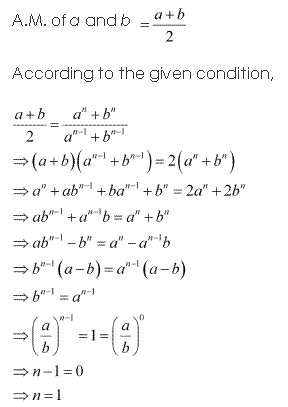
Question 16:
Between 1 and 31, m numbers have been inserted in such a way that the resulting sequence is an A.P. and the ratio of 7th and (m – 1)th numbers is 5 : 9. Find the value of m.
Ans:
Let A1, A2, A3, A4, … Am be m A.Ms.between 1 and 31.
Therefore, 1, A1, A2, A3, ……… Am, 31 are in A.P.
Let d be the common difference of AP.
Here, the total number of terms is m + 2 and Tm + 2 = 31
⇒ 1 + (m + 2 – 1) d = 31
⇒ (m + 1) d = 30
⇒ d = \(\frac{30}{m + 1}\) ……………….(i)
A7 = T8 = a + 7d
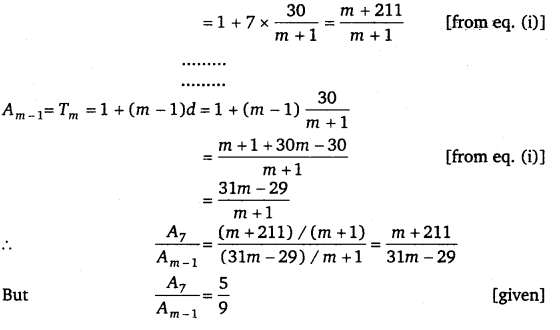
\(\frac{m+211}{31 m-29}=\frac{5}{9}\)
⇒ 9m + 1899 = 155m – 145
⇒ 146m = 2044
⇒ m = \(\frac{2044}{146}\) = 14
∴ m = 14
Question 17:
![]()
Ans:
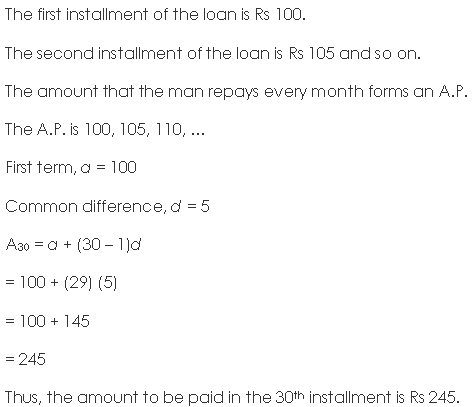
Question 18:
The difference between any two consecutive interior angles of a polygon is 5°. If the smallest angle is 120°, find the number of the sides of the polygon.
Ans:
The angles of the polygon will form an A.P. with common difference d as 5° and first term a as 120°.
It is known that the sum of all angles of a polygon with n sides is 180° (n – 2).
∵ Sn = 180° (n – 2)
\(\frac{n}{2}\) [2a + (n -1) d] = 180° (n – 2)
\(\frac{n}{2}\) [240° + (n – 1) 5°] = 180 (n – 2)
n [240 + (n – 1) 5] = 360 (n – 2)
240n + 5n2 – 5n = 360n – 720
⇒ 5n2 + 235n – 360n + 720 = 0
⇒ 5n2 – 125n + 720 = 0
⇒ n2 – 25n + 144 = 0
⇒ n2 – 16n – 9n + 144 = 0
⇒ n (n – 16) – 9 (n – 16) = 0
⇒ (n – 9) (n – 16) = 0
⇒ n = 9 or 16.
NCERT Solutions for Class 11 Maths Chapter 9 Sequences and Series (अनुक्रम तथा श्रेणी) Hindi Medium Ex 9.2
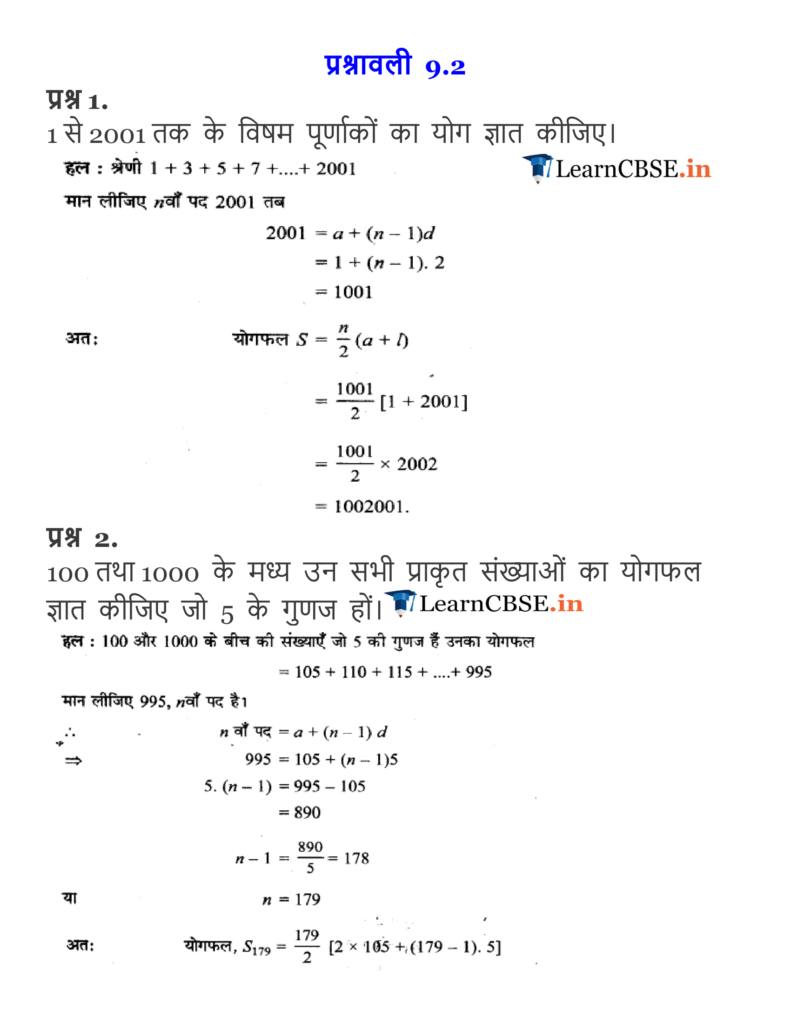

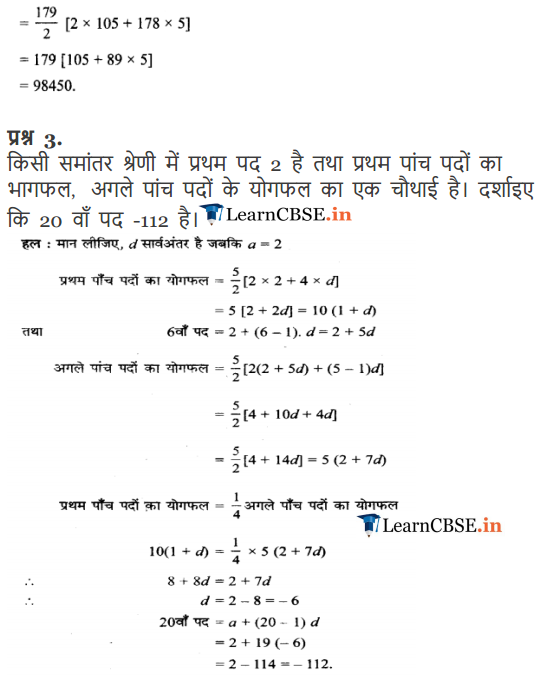

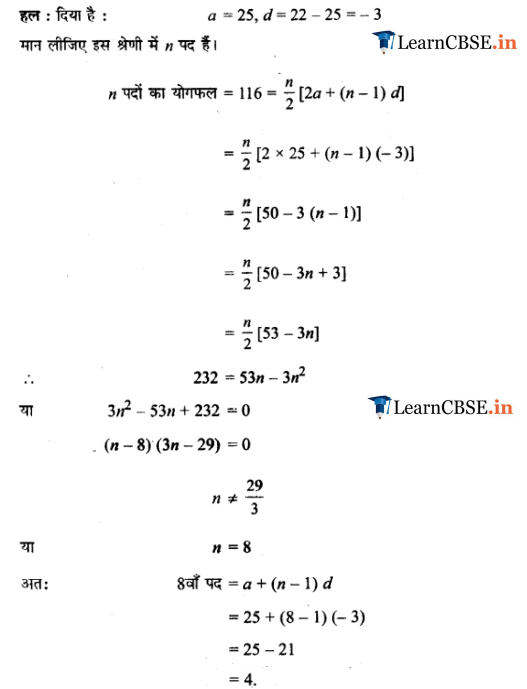
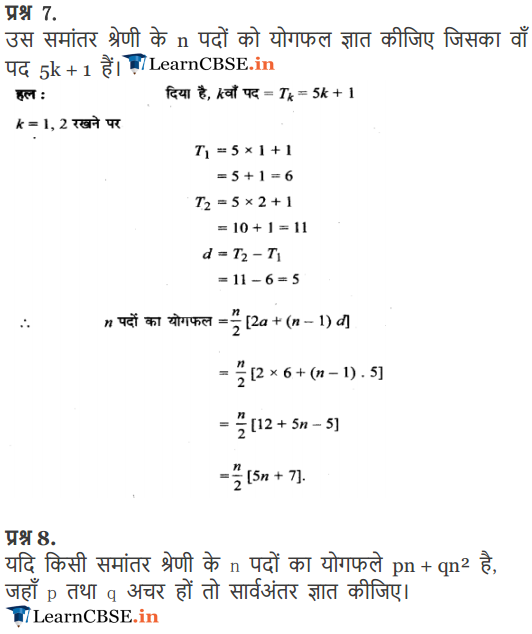
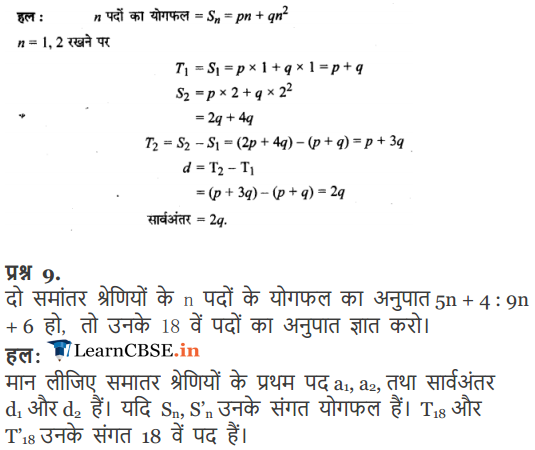
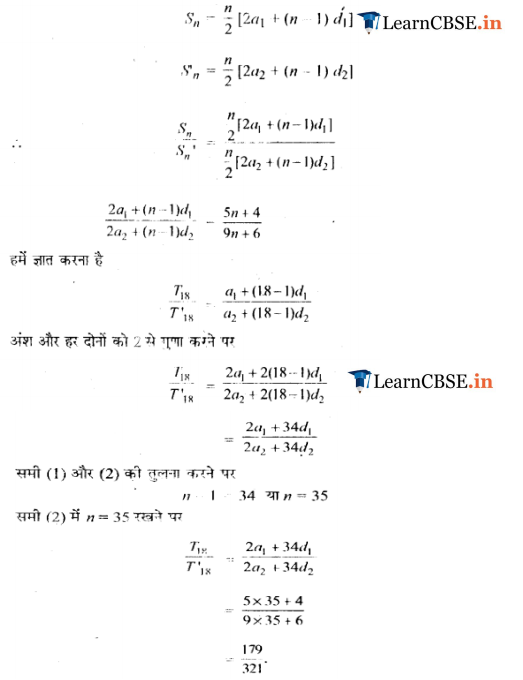
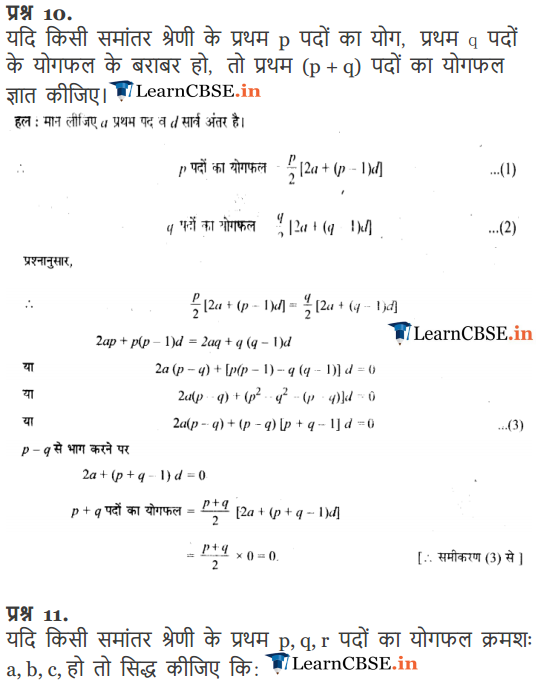
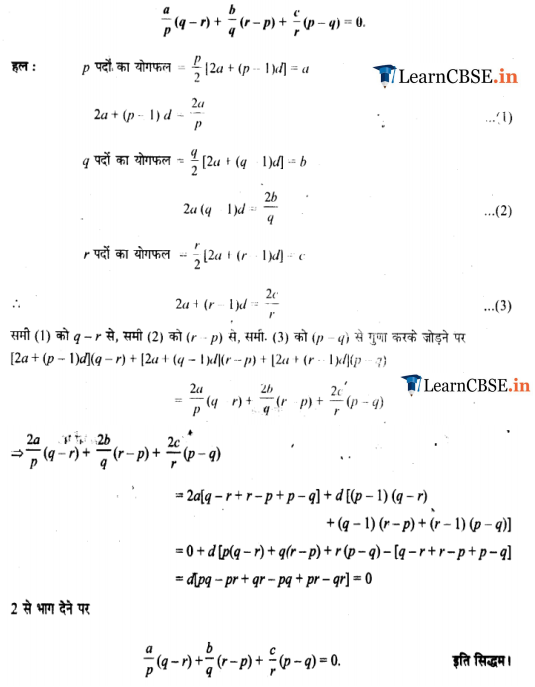
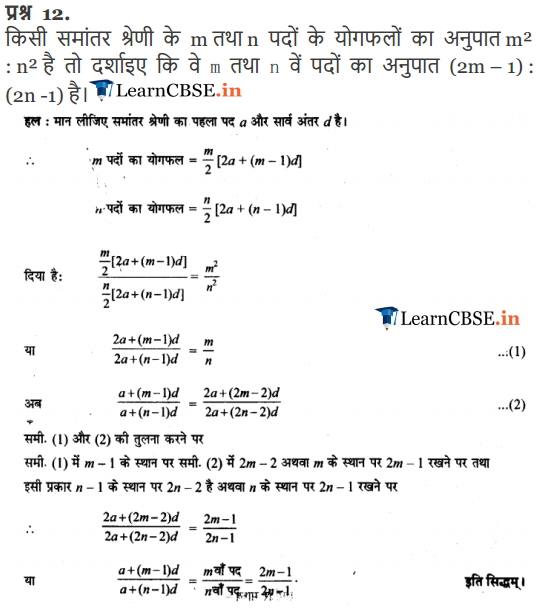
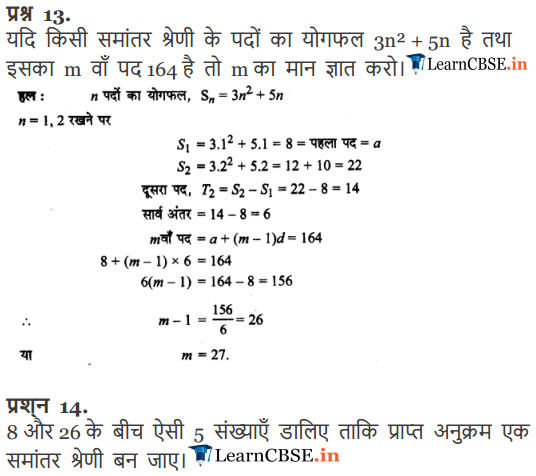
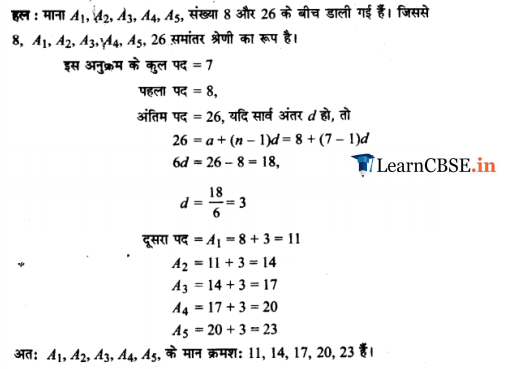
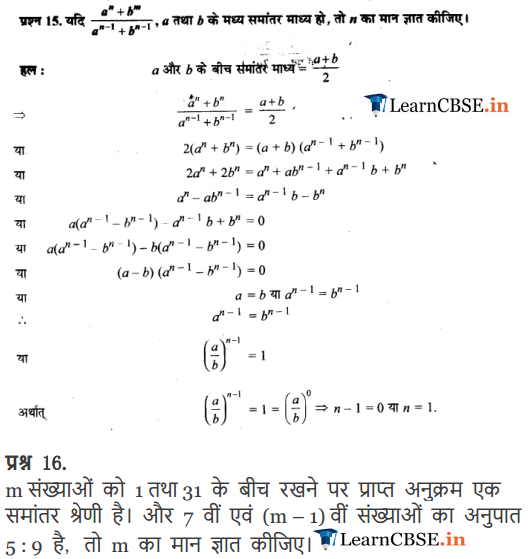



NCERT Solutions for Class 11 Maths All Chapters
-
- Chapter 1 Sets
- Chapter 2 Relations and Functions
- Chapter 3 Trigonometric Functions
- Chapter 4 Principle of Mathematical Induction
- Chapter 5 Complex Numbers and Quadratic Equations
- Chapter 6 Linear Inequalities
- Chapter 7 Permutation and Combinations
- Chapter 8 Binomial Theorem
- Chapter 9 Sequences and Series
- Chapter 10 Straight Lines
- Chapter 11 Conic Sections
- Chapter 12 Introduction to Three Dimensional Geometry
- Chapter 13 Limits and Derivatives
- Chapter 14 Mathematical Reasoning
- Chapter 15 Statistics
- Chapter 16 Probability